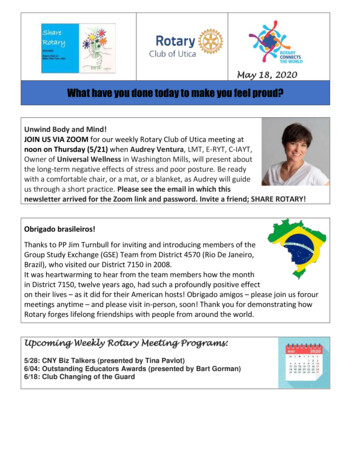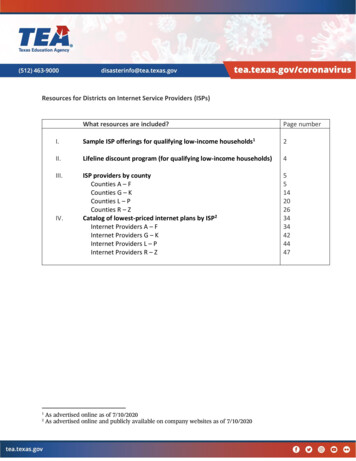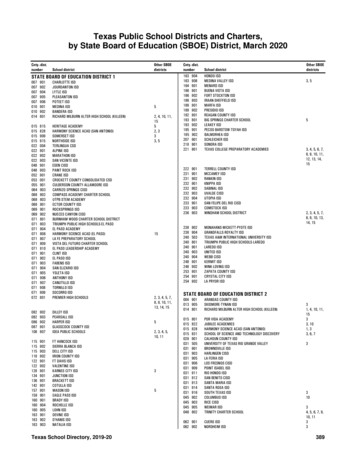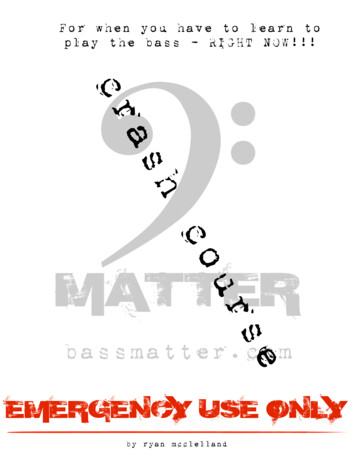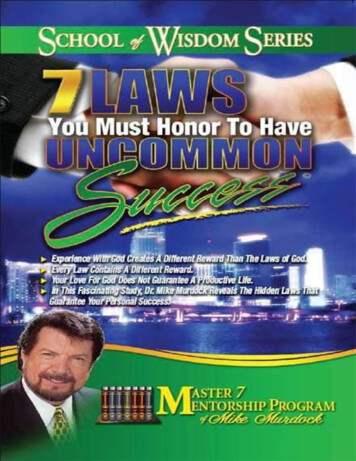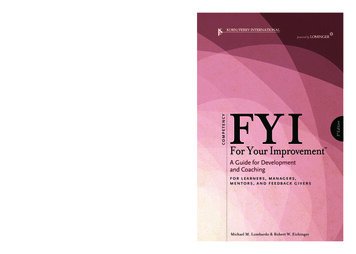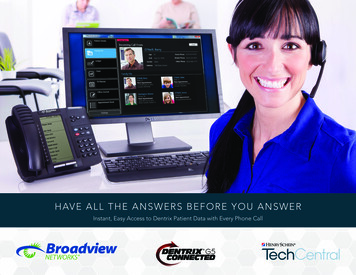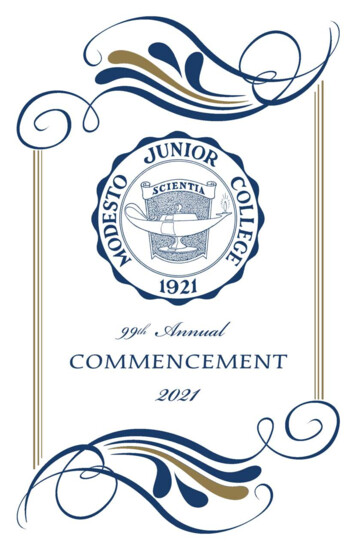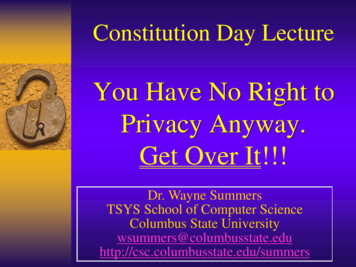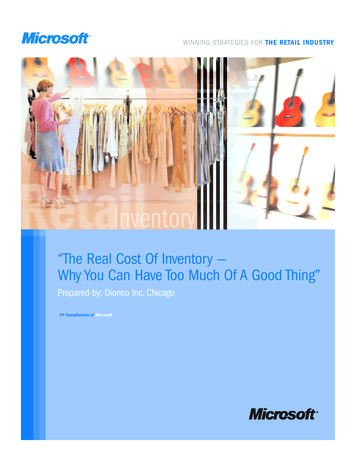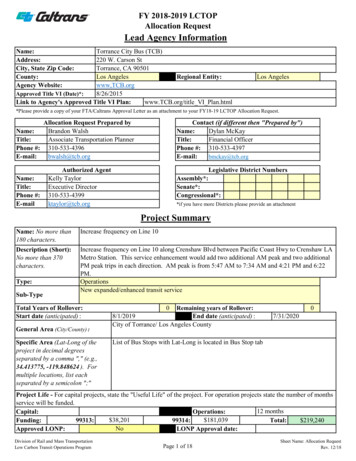
Transcription
FY 2018-2019 LCTOPAllocation RequestLead Agency InformationName:Address:City, State Zip Code:County:Agency Website:Torrance City Bus (TCB)220 W. Carson StTorrance, CA 90501Los AngelesRegional Entity:www,TCB.orgApproved Title VI (Date)*:8/26/2015Link to Agency's Approved Title VI Plan:www.TCB.org/title VI Plan.htmlLos Angeles*Please provide a copy of your FTA/Caltrans Approval Letter as an attachment to your FY18-19 LCTOP Allocation Request.Allocation Request Prepared byName:Brandon WalshTitle:Associate Transportation PlannerPhone #: 310-533-4396E-mail:bwalsh@tcb.orgName:Title:Phone #:E-mailContact (if different then "Prepared by")Name:Dylan McKayTitle:Financial OfficerPhone #: 310-533-4397E-mail:bmckay@tcb.orgAuthorized AgentKelly TaylorExecutive Director310-533-4399ktaylor@tcb.orgLegislative District NumbersAssembly*:Senate*:Congressional*:*if you have more Districts please provide an attachmentProject SummaryName: No more than180 characters.Increase frequency on Line 10Description (Short):No more than 370characters.Increase frequency on Line 10 along Crenshaw Blvd between Pacific Coast Hwy to Crenshaw LAMetro Station. This service enhancement would add two additional AM peak and two additionalPM peak trips in each direction. AM peak is from 5:47 AM to 7:34 AM and 4:21 PM and 6:22PM.OperationsNew expanded/enhanced transit serviceType:Sub-TypeTotal Years of Rollover:Start date (anticipated) :General Area (City/County) :Specific Area (Lat-Long of theproject in decimal degreesseparated by a comma "," (e.g.,34.413775, -119.848624 ). Formultiple locations, list eachseparated by a semicolon ";"0 Remaining years of Rollover:End date (anticipated) :8/1/2019City of Torrance/ Los Angeles County7/31/20200List of Bus Stops with Lat-Long is located in Bus Stop tabProject Life - For capital projects, state the "Useful Life" of the project. For operation projects state the number of monthsservice will be funded.12 monthsCapital:Operations: 38,201 181,039Funding:99313:99314:Total: 219,240NoApproved LONP:LONP Approval date:Division of Rail and Mass TransportationLow Carbon Transit Operations ProgramPage 1 of 18Sheet Name: Allocation RequestRev. 12/18
FY 2018-2019 LCTOPAllocation RequestFunding InformationLCTOP Allocation YearPUC 99313 Amount:PUC 99314 Amount:Total LCTOP Funds:Other GGR Funds:Other Funds:Total Project Cost:PriorFY 18-19FY 19-20FY 20-21FY 21-22FY 22-23Total 38,201 181,039 38,201 181,039 0 219,240 0 0 0 0 219,240 0 0 0 219,240 0 0 0 0 219,240Lead Agency:Contact Person:Contact Phone #:Contact E-mail:Torrance City Bus (TCB)Dylan McKay310-533-4397bmckay@tcb.orgAmount:Contributing Sponsor:Contact Person:Contact Phone #:Contact E-mails:Los Angeles Council of GovernmentsDonna Martin213-902-1000Amount: 38,201PUC Funds Type:9931399314Contributing Sponsor:Contact Person:Contact Phone #:Contact E-mails:Amount:PUC Funds Type:9931399314Contributing Sponsor:Contact Person:Contact Phone #:Contact E-mails:Amount:PUC Funds Type:9931399314Contributing Sponsor:Contact Person:Contact Phone #:Contact E-mails:Amount:PUC Funds Type:9931399314Contributing Sponsor:Contact Person:Contact Phone #:Contact E-mails:Amount:PUC Funds Type:9931399314 181,039PUC Funds Type:9931399314Donna.Martin@LACOG.govTotal FY 18-19 LCTOP Funding 219,240Supplanting Funds - Describe how the LCTOP funds will not supplant other funding sources.Without this LCTOP funding TCB would be unable to increase this service.Fully Funded Project - Provide a description of the status of all the funds to be used to completely fund this project.LCTOP funds are the only funds to be used for this proposed project.Division of Rail and Mass TransportationLow Carbon Transit Operations ProgramPage 2 of 18Sheet Name: Allocation RequestRev. 12/18
FY 2018-2019 LCTOPAllocation RequestFunding PlanComponentProposed Total Project CostFY 18-19FY 19-20FY 20-21FY 21-22PriorPA&EDPS&ER/WCONVeh/Equip PurchaseOperations/OtherTOTALFunding Source:Component 0 0 0 0 0 0 0 0 0 0 0 0 0 0 0 0 0 0 0 0 0 0 0 0 0 0 0 0 0 0 0 0 0 0 0 0 0 0 0 0 219,240 0 0 0 0 0 219,240 0 219,240 0 0 0 0 0 219,240FY 20-21FY 21-22FY 22-23FY 23-24Total 0 0 0 0 219,240 219,240 0Prior 219,240FY 18-19 0FY 19-20 0FY 20-21 0FY 21-22 0FY 22-23 0FY 23-24 219,240Total 0 0 0 0 0 0 0PriorPA&EDPS&ER/WCONVeh/Equip PurchaseOperations/OtherTOTALFunding Source:ComponentTotal 0PA&EDPS&ER/WCONVeh/Equip PurchaseOperations/OtherTOTALFunding Source:ComponentFY 23-24 0Low Carbon Transit Operations Program (LCTOP)ComponentPriorFY 18-19FY 19-20PA&EDPS&ER/WCONVeh/Equip PurchaseOperations/OtherTOTALFY 22-23 0FY 18-19 0FY 19-20 0FY 20-21 0FY 21-22 0FY 22-23 0FY 23-24 0Total 0 0 0 0 0 0 0PriorPA&EDPS&ER/WCONVeh/Equip PurchaseOperations/OtherTOTALDivision of Rail and Mass TransportationLow Carbon Transit Operations Program 0FY 18-19 0FY 19-20 0FY 20-21 0FY 21-22 0FY 22-23 0FY 23-24 0Total 0 0 0 0 0 0 0 0 0Page 3 of 18 0 0 0 0 0Sheet Name: Allocation RequestRev. 12/18
FY 2018-2019 LCTOPAllocation RequestFunding PlanFunding Source:ComponentPriorPA&EDPS&ER/WCONVeh/Equip PurchaseOperations/OtherTOTALFunding Source:ComponentFY 21-22FY 22-23FY 23-24Total 0 0 0 0 0Prior 0FY 18-19 0FY 19-20 0FY 20-21 0FY 21-22 0FY 22-23 0FY 23-24 0Total 0 0 0 0 0 0 0Prior 0FY 18-19 0FY 19-20 0FY 20-21 0FY 21-22 0FY 22-23 0FY 23-24 0Total 0 0 0 0 0 0 0PriorPA&EDPS&ER/WCONVeh/Equip PurchaseOperations/OtherTOTALFunding Source:ComponentFY 20-21 0PA&EDPS&ER/WCONVeh/Equip PurchaseOperations/OtherTOTALFunding Source:ComponentFY 19-20 0PA&EDPS&ER/WCONVeh/Equip PurchaseOperations/OtherTOTALFunding Source:ComponentFY 18-19 0FY 18-19 0FY 19-20 0FY 20-21 0FY 21-22 0FY 22-23 0FY 23-24 0Total 0 0 0 0 0 0 0PriorPA&EDPS&ER/WCONVeh/Equip PurchaseOperations/OtherTOTALDivision of Rail and Mass TransportationLow Carbon Transit Operations Program 0FY 18-19 0FY 19-20 0FY 20-21 0FY 21-22 0FY 22-23 0FY 23-24 0Total 0 0 0 0 0 0 0 0 0Page 4 of 18 0 0 0 0 0Sheet Name: Allocation RequestRev. 12/18
FY 2018-2019 LCTOPAllocation RequestProject/Agency InformationProject Description - Describe the project using comprehensive overall project description regarding improvements to bemade and/or increased level of service (include for operations projects number of trips, span, frequency improvements andnumber of days of operation; for capital projects include product specifications). No more than 10 lines .The proposed project would increase frequency on Line 10 along Crenshaw Blvd between Pacific Coast Hwy to CrenshawLA Metro Station. This service enhancement would add two additional AM peak and two additional PM peak trips in eachdirection and would operate Monday through Friday, 252 days in the first year. AM peak is from 5:47 AM to 7:34 AM and4:21 PM and 6:22 PM. Line 10 currently operated on the proposed route providing all day service between Crenshaw Blvdbetween Pacific Coast Hwy to Crenshaw LA Metro Station, however many of the AM and PM peak trips are experiencingover crowding with passengers standing for much of the 9.5 mile trip.Agency Service Area - Describe the project area including the city, town, community (rural, suburban, urban &demographics). No more than 10 lines.The City of Torrance encompasses an area of approximately 21 square miles and has an estimated population of 146,115,which makes Torrance one of the top 10 most populated cities in Los Angeles County. Residents have a high median ageof about 42 years, and over a third of the population are Asian Americans. Torrance has the second-highest population ofJapanese Americans in the United States. Our population has a median income of 75,549, and 46% of residents over age25 have a bachelor's degree or higher. A third of households have children under the age of 18 living with them.Agency Service - Describe the service you provide and how the project plays into your overall operations plan. No morethan 10 lines.Approximately 60% of our routes and service are outside of the City of Torrance proper, serving disadvantagedcommunities and cities with a high density of low-income residents. Our service operates from the South Bay toDowntown Los Angeles, and from Redondo Beach to Long Beach. We operate fixed route bus service on 11 lines,including a Rapid Bus Line and an Express Line. A copy of our system map, service area, and a map of the disadvantagedcommunities that we service is attached. We host El Camino Community College, the ITT Technical Institute of Torrance,and Westwood College of South Bay, while our buses also service Cal State Dominguez Hills. The Torrance Transit Parkand Ride Regional Terminal is a seven acre facility currently being constructed and will serve as a multi-modaltransportation hub in the South Bay region, connecting bus, car, bicycle and in the near future, light rail service (thisfacility is the future terminus of the Metro Green line Light Rail).Agency Fare - Describe the fare structure for your system and how the project will affect that structure if at all.We charge a base fare of 1.00; we charge senior, disabled, and Medicare patrons 0.25; we charge students 0.50;children ride for free. Interagency transfers cost 0.40. None of these fares will be affected by our project.Division of Rail and Mass TransportationLow Carbon Transit Operations ProgramPage 5 of 18Sheet Name: Allocation RequestRev. 12/18
FY 2018-2019 LCTOPAllocation RequestProject/Agency Information (continued)Project Costs - Describe the assumptions and process for how the projects costs were developed. No more than 10 lines.The proposed project used the following assumptions to develop a total project cost: 4 additional trips, each 1.5 hours longequals 6 additional revenue service hours per day, 252 days of service (in the first year) equals 1,512 additional revenueservice hours for the first year. At a cost of 145 per revenue service hour (system wide average cost) estimated totalproject cost is 219,240Project Planning - Explain the planning process this project went through, including any public outreach/input, or workshopIncreasing service on Route 10 is a core element of TCB Short-Range Transit Plan. This plan was presented before our citycouncil and was open to public input and comment. TCB monitors and analyzes its service provision data on a continuousbasis, and receives operational information from bus operators. Route service has shown consistently heavy ridership formany years. Public outreach was conducted in 2016 when this and other routes were modified, and two additional buseswere added to the route. We have also recently conducted a comprehensive system analysis to obtain additional informationfrom which to plan service changes and determine efficiencies; that analysis confirms the continued need for Route 10expansion.Environmental Justice - Explain how your agency designed the project to avoid substantial burden on any low incomedisadvantaged community.The provision of additional buses on this heavily traveled transit corridor relieves overcrowding during peak commuteperiods, thus would not impose any substantial burden on any low income disadvantaged community.Division of Rail and Mass TransportationLow Carbon Transit Operations ProgramPage 6 of 18Sheet Name: Allocation RequestRev. 12/18
FY 2018-2019 LCTOPAllocation RequestProject GHG BenefitsGreenhouse Gas Reductions - Describe qualitatively how this project will reduce greenhouse gas emissions. Forexample, expanded/enhanced transit service will improve headways thus making transit a more convenient option oftransportation thus increasing ridership, reducing Vehicle Miles Traveled (VMT) and reducing GHG.The expanded transit service will reduce VMT and greenhouse gas emissions by replacing auto trips with transit trips.Expansion to the service by 4 additional trips are estimated to added approximately 133 commuter bus riders per day toreplace an average auto trip of 9 miles each directionGreenhouse Gas Reductions - Please provide quantitative information requested below and explanation/support for thedata provided.ValueExplanationService is to begin September 1, 2019, and this grantYear 1 (Yr1) - First year of service, or yearwill pay to operate the service for one yearthat capital improvements will be completed.2019Year F (YrF) - Final year that the service isfunded or the final year of the capitalimprovements useful life.Project Yr1 Ridership - Estimated annualridership contributed by the new service orcapital improvement in Yr1.Project F Yr. Ridership - Estimated annualridership contributed by the new service orcapital improvement in YrF.Adjustment (A) - Adjustment factor to accountfor transit dependency. Default: 0.5 for localbus service and 0.83 for long distance commuteservice.Trip Length (L) - Length (miles) of averageauto trip reduced or average passenger triplength (miles).Project Useful LifeTotal Project Ridership IncreasedTotal Project VMTs ReducedEstimated Total Project GHG (mtco2)Reduction:LCTOP Emission Reductions/Total LCTOP Funds RequestedDivision of Rail and Mass TransportationLow Carbon Transit Operations ProgramThe one year of operations would end August 31, 2020202033,264The current average riders per hour of service onRoute 10 is 30 passengers per hour. Staff estimatedthe new service to have an average of 22 passengers inthe first year 22 x 1512 hours of service 33,26433,264The current average riders per hour of service onRoute 10 is 30 passengers per hour. Staff estimatedthe new service to have an average of 22 passengers inthe first year 22 x 1512 hours of service 33,265Using the default for local bus service0.504.61133,26476,67416.4274.90349Page 7 of 18Per our February 2018 Ridcheck Plus SurveySummary, our average passenger trip length is 4.61miles. The survey is attached, with the final averagehighlighted on page 4 of the survey results.This is calculated based on the values above.This is calculated based on the values above.This number is calculated based on the valuesabove.This number is calculated based on the values fromabove and the QM-Tool tab.This number is calculated based on the values fromabove and the QM-Tool tab.Sheet Name: Allocation RequestRev. 12/18
FY 2018-2019 LCTOPAllocation RequestProject BenefitsJob retention/creation BenefitsPrimary Project Activity (select from drop down)% of Project Budget Associate with Primary ActivityTertiary Project Activity (select from drop down)% of Project Budget Associate with Tertiary ActivityTertiary Project Activity (select from drop down)% of Project Budget Associate with Tertiary ActivityTravel Cost Savings BenefitsOperation of local transit service, including mixed mode100.00%ValueExplanationStandard Fare Cost for Project ( /Trip) 1.00A base fare of 1Reduced Fare Cost ( /Trip) 0.00N/ATransit Facility Parking Cost ( /Trip) 0.00N/AAvoided Parking Cost ( /Trip) 5.00The cost it would have been to pay for parkingAvoided Toll Cost ( /Trip) 0.00N/ATransit Mode Share (increase mobility): Describe how this project will increase transit mode share (increase mobility).The additional trips will increase mobility in communities along the route increasing the number of mass transitopportunities and residents abilities to travel throughout the region (as the route serves a Metro rail station and twoairports). Staff estimated the new service to have an average of 22 passengers in the first year 22 x 1512 hours of service 33265Co-Benefits - Check all additional Benefits/Outcomes.XImproved SafetyImproved Public HealthReduced Operating/Maintenance CostsIncrease System ReliabilityOther BenefitsXCoordination with Educational InstitutionCollegeGrades K-12Promotes Active TransportationPromotes Integration w/ other modesCo-Benefits - Describe benefits indicated above and other benefits not listed.Division of Rail and Mass TransportationLow Carbon Transit Operations ProgramPage 8 of 18Sheet Name: Allocation RequestRev. 12/18
FY 2018-2019 LCTOPAllocation RequestPriority Populations BenefitsDoes your Service Area have a Disadvantaged Community? (as defined by SB 535)Does the Project Benefit a Disadvantaged Community?Does the Project Benefit a Low Income Community or a resident of a Low-Income Household?Does the Project Benefit a Low Income Community or a resident of a Low-Income Householdwith in a 1/2 of a Disadvantaged Community?Is the project a new or expanded transit service that connects with transit service serving adisadvantaged communities?YesYesYesYesYesIs the project a transit fare subsidies or network and fare integration technology improvements,including, but not limited to, discounted or free student transit passesIs the project a purchase of zero-emission transit buses and/or supporting infrastructure?Identify the Project Census Tract(s)(please use the 10-digit identificationcode) :NoNo603765091, 6037980005, 6037603702, 6037603704, 6037602507,6037602506, 6037602509, 6037670003Identify the approach your agency used D. Refer to the list of common needs for disadvantaged communities into identify AB 1550 Community Need CARB’s Funding Guidelines Table 2-2 and select a project that addresses(for more information please review AB a listed need.1550 Needs tab):ECON 5 Reduce transportation costs (e.g., free or reduced cost transitIdentify Specific AB 1550 GroupCommon Needs (if you select letter D. in passes) and improve access to public transportation (e.g., new services inunder-served urban and rural communities).question above):D.Priority Populations Community Need: Describe, in detail the identified community need(s) and how the project meetsthe need(s), including the levels of community engagement.TCB used a variety of approaches to determine community need including referring to the list of common needs fordisadvantaged communities in the CARB's Funding Guidelines Table 2-2. Staff has worked with members of theCrenshaw Blvd. Community on many occasions including the public hearing held on Thursday, February 15, 2019 whenthe City Council voted to use LCTOP funds to increase service on Line 10.Identify the Specific PriorityPopulation Benefit:Division of Rail and Mass TransportationLow Carbon Transit Operations ProgramA. Project provides improved transit or passenger rail service for stationsor stops within a disadvantaged or low-income community (e.g., newtransit lines, more frequent service, greater capacity on existing lines thatare nearing capacity, improved reliability, improved accessibility, busrapid transit service);Page 9 of 18####Sheet Name: Allocation RequestRev. 12/18
FY 2018-2019 LCTOPAllocation RequestDAC Benefit - Explain, in your own words, how the project will benefit Disadvantaged Community(ies) within yourservice area.The improved service on Line 10 will increase Crenshaw Blvd. communities access to affordable, reliable and convenientmass transportation service both within Torrance and within the region. Line 10 benefits DAC by connecting low incomeresidents to educational facilities, medical offices, major employment centers in the Greater South Los Angeles area andDowntown Los Angeles via light rail at the Metro Green Line Station.Low-Income Community or Low-Income Household Benefit - Explain, in your own words, how the project will benefitLow-Income Community(ies) or Low-Income Households within the project area.The improved service on Line 10 will increase Crenshaw Blvd. communities access to affordable, reliable and convenientmass transportation service both within Torrance and within the region. Line 10 benefits DAC by connecting low incomeresidents to educational facilities, medical offices, major employment centers in the Greater South Los Angeles area andDowntown Los Angeles via light rail at the Metro Green Line Station.Low-Income Community or Low-Income Household within 1/2 a mile of a Disadvantaged Community Benefit Explain, in your own words, how the project will benefit Low-Income Community(ies) or Low-Income Households withinthe project area.Amount funds to benefit a DAC: Amount funds to benefit Low-Income Households & Residents: Amount f
and Westwood College of South Bay, while our buses also service Cal State Dominguez Hills. The Torrance Transit Park and Ride Regional Terminal is a seven acre facility currently being constructed and will serve as a multi-modal
